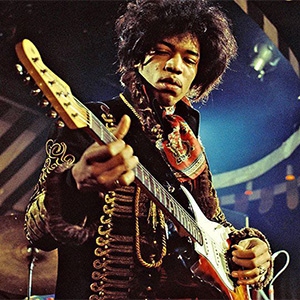
Jimi Hendrix

On September 18, 1970, a television in a Stockholm living room lit up, as the legendary Neoclassical guitar shredder Yngwie Malmsteen, then seven years old, watched footage of Jimi Hendrix sacrificially burning his Fender Stratocaster during the 1967 Monterey Pop Festival. The footage was part of a news segment announcing the death Hendrix at just 27 years of age. Malmsteen stated that it was at that moment that he knew he wanted to play Rock guitar for a living. Maybe it was the aesthetic of watching a guitar maestro burn his guitar, the danger and rebellion of it, that inspired Malmsteen. However, and Malmsteen agrees, Hendrix was not just known for his on-stage antics: The man could play electric guitar, and he played the electric guitar like it was an electric guitar and not just an amplified acoustic guitar. This means he made good use of controlled feedback and effects—including the wah-wah, fuzz, octavia, and univibe pedals—to create mind-expanding soundscapes like no other rock guitarist before him. Jimi didn't need to take LSD (although he did) because he WAS LSD: He took the Rhythm & Blues he played on Chitlin Circuit in the early '60s and filtered it through the sonic kaleidoscope in his brain. The Jimi Hendrix Experience's 1967 album Are You Experienced, is considered by many to be one of the most important debuts in Rock history, heralded by guitar legend Steve Vai as the first major paradigm shift in electric guitar.
Jimi Hendrix did not have a privileged upbringing. There was no piano in the house—let alone any fully functioning guitar–with a parent standing over him ordering him to practice his music. In fact, he had to beg his father to buy him his first guitar, an acoustic, when he was 15 years old. Prior to this, Jimi had been using an old ukelele with one string on it as a makeshift guitar and he had even been seen carrying around an old broom, strumming its broomsticks and holding it almost like a security blanket. Finally, in 1959, his father, Al Hendrix, bought him his first electric guitar—a Supro Ozark. Jimi didn't have any formal guitar instruction, he learned by ear, listening to records by artsits such as Muddy Waters, Robert Johnson, and Elmore James. He would also hang out on the Seattle music scene as a teen, and ask local guitarists such as Billy Davis how to play certain things.
Jimi did not have a strong background in music theory. Once Miles Davis was hanging out with Jimi and said he liked this diminished chord he used on some number. Jimi asked what a diminished chord was and Miles showed him. Then Jimi proceeded to play diminished chords all over the guitar neck. This impressed Davis who stated that Jimi had an incredible ear and feel for music. Miles Davis was not the only formally trained musician who was impressed by Jimi. It is true that some guitar shredders in the Prog, Metal, and Neoclassical vein scoff at Jimi being touted as one of the best, if not the best, Rock guitar players of all time. After all, he mostly played in the Minor Pentatonic Scale, or Blues Scale. However, two of the most renowned shredders of the 1980s, Jason Becker and Shawn Lane, have stated that they admire Jimi Hendrix as both a songwriter and a player. During the famous G3 concerts which feature modern electric guitar heroes such as Steve Vai, Eric Johnson, Joe Satriani, and Paul Gilbert, Jimi's music is often covered to pay homage to his contribution to modern electric guitar.
I myself, having studied theory and modern techniques such as sweeping and tapping for about 10 years now, realize that Hendrix could not pull off these techniques, at least they were not in his repertoire. I do feel that he had the talent to learn them, but would he be learning them to prove he could do them, or would he actually enjoy the way these guitar conventions sound? Many of today's electric guitar virtuosos recognize Jimi Hendrix as an electric guitar innovator in that he made good use of his tremolo arm (this is before the days of Floyd Rose or Kahler tremolo systems), effects pedals, and feedback, and was constantly seeking new ways to speak through his guitar. And in the studio, recording engineer, the legendary, Eddie Kramer who recorded and engineered most of Jimi's music, stated that working with Jimi was like working with a modern master composer. That's pretty high praise from a man who recorded some of rock's finest artists. Little Richard—whose band Jimi played in before becoming a star— famously told one journalist that Hendrix wanted to make you feel high and take you to a transcendent place with his music.
I can honestly say that as a teen in the summer of 1993, I listened to Hendrix religiously (particularly the compilation The Ultimate Experience) and it changed not only my view of music but also my view of life. It was like Jimi's music had opened up parts of my mind that allowed me to see new possibilities of how I could express myself through music, in particular, through the guitar. Hendrix was a visionary and his vision gave me the vision which prompted me to ask my late father, David Kidd, to buy me an electric guitar. I was fortunate. Unlike Jimi, I didn't need to beg my dad, and in August of 1993 we went to a local music store and he purchased my first guitar—a Yamaha Pacifica 912. Then, about two years later, when he saw I was serious about playing, he bought me my aqua blue Fender Lonestar Stratocaster, which I still own today.
When I was putting together my thoughts about Jimi and the other guitar players on this page, I began to realize that what I like most about guitar players in the rock genre, and probably otherwise, is their ability to play rhythm guitar. Soloing is nice when it fits in the song and is not just showing off. Quite frankly, I sometimes get bored with rapid solos that sometimes seem more self-indulgent than adding to the impact of the song. Jimi more than anything else was a superb rhythm guitar player (the songs "Gypsy Eyes" and "Message of Love" immediately come to mind) and he was a master in the studio at layering guitar parts ("All Along the Watchtower" and "Bold as Love" come to mind.) Don't get me wrong, I appreciate today's guitar electric guitar virtuoso's and I sometimes do enjoy tasty shred guitar. However, I like to think of the rhythm guitar being the most important part of a song and the lead parts being nice complements to the rhythm parts. Some like the opposite: the rhythm as being a nice complement to the leads, and that is fine. After all, music is subjective. Whether you think that Jimi was as technically sound as his potential or not, it is hard to argue that as Steve Vai stated, Jimi Hendrix was the first of only two Rock guitarists (the other being Eddie Van Halen) to create a major electric guitar paradigm shift. I would add that he is also the godfather of modern rock guitar...I mean...to me, anyway...
Song Example
The Jimi Hendrix Experience - Gypsy Eyes
official website
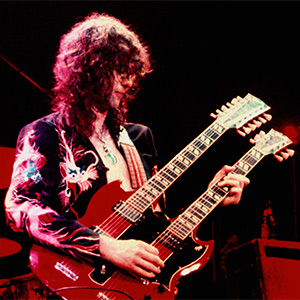
Jimmy Page

When Jimmy Page founded Led Zeppelin in 1968 at the age of 24, he was already a seasoned professional guitarist. Page did some notable session work on popular songs such as Jeff Beck's "Bolero," The Rolling Stone's "Heart of Stone," Joe Cocker's "With a Little Help From My Friends," Donovon's "Sunshine Superman," and even the James Bond theme, "Goldfinger," along with eventually becoming the primary guitarist in the Yardbirds, a station previously held by both Eric Clapton and Jeff Beck. However, very little of Page's previous work (except maybe a few originals with the Yardbirds) hinted at what Page called the idea of "light and shade" where light, sometimes acoustic, parts would combine with heavy, dark (shady), and distorted blues-inspired riffs. Some credit this idea as being part of what eventually would become heavy metal, but Page's guitar playing was just as influenced by British Folk-Rock, Moroccan, and Indian music as it was American Blues. A classic example of the "light and shade" style is Zep's cover of the Joan Baez song, "Babe I'm Gonna Leave You," on Led Zeppelin I.
To me, in the early 1970s, two main guitar players acted as a transition or bridge between the popular blues-based rock of the 1960s and what would later become Metal, Neoclassical, or even Shred of the late 1970s and 1980s—those players being Ritchie Blackmore and Jimmy Page. (I left out Prog Rock guitarists like Steve Howe and Robert Fripp only because although both are very good, I view Prog as a different branch on the Rock family tree with a lineage that doesn't directly relate to Metal.) Although Blackmore might arguably be a more technically accurate guitar player than Page, and both often performed in alternate tunings and scales outside of the Minor Pentatonic, and both played some solos at incredibly fast speeds while employing techniques that were not just based in American Blues—Page just wrote cooler/more interesting riffs and cooler/more interesting songs. Interestingly, in the early days (Daze) of Zep, Page played a hand-painted yellow Fender Telecaster and his playing was a bit sharper. However, wearing his Gibson Les Paul guitar near his knees (and perhaps imbibing and indulging a bit too much before some live shows) might have possibly hampered his technical prowess a bit at times. But even so, Page's live playing would emit blissful tones that no other guitar player at the time or since has been able to replicate and his compositions were just as magnificent. And in the studio, forget it, he was unmatched for his originality as a producer AND player.
I especially enjoy the Led Zep albums Houses of Holy and Physical Graffiti in they contain mostly original material and the band seems to have polished its sound, with Page at the helm much of the time, as both a producer and songwriter. The track "The Song Remains the Same" opens up Houses of the Holy with Page's amazing rhythm guitar playing. It also showcases his unique bending style on the lead guitar passages. This album also contains the beautiful ballad "The Rain Song," written by Page in the tuning, DGCGCD. Physical Graffiti's "Kashmir"—written in one of Page's favorite alternate tunings: DADGAD—contains one of the most recognizable guitar riffs of all time and was inspired by traveling through the Sahara Desert. Even when Page was not the primary songwriter, like when bassist John Paul Jones took over much of the writing duties for the band's album In Through The Out Door, Page would be still able to pull off things that no other guitarist could. For example, during the song "Fool in the Rain" Page uses the (in)famous MXR Blue Box Octave Fuzz Pedal during his solo (and some of the later chorus parts), and it sounds wonderful. Any guitar player who has used the Blue Box knows that it is hard to make it work in just about any song, but when it does work, it often sounds great.
Carlos Santana called Jimmy Page the Igor Stravinsky of the Les Paul. I suppose Santana means that he is a master Rock composer, and gets sounds out of the Les Paul that few other guitarists have ever been able to. I concur with Santana: Jimmy Page is a very good composer, performer, and all-around unique guitar talent.
Song Example
Led Zeppelin - Achilles Last Stand
official website
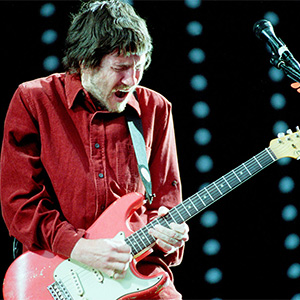
John Frusciante

For me, the name John Frusciante automatically evokes visions of the Hollywood Hills at dusk, with the sun setting and tranquil guitar passages lulling me into a meditative trance. (Either that, or me dancing to a funky-ass guitar lick on the Venice Beach Boardwalk.) Mr. Frusciante was just 18 when he joined the Red Hot Chili Peppers (RHCP) after the untimely death of another guitar sage (or perhaps funky monk) Hillel Slovak—the main guitarist for the RCHP from 1980 - 1988. His impact on the band was immediate as Frusciante (who was influenced by Jimi Hendrix as much as he was Frank Zappa) put his Midas guitar touch on tracks such as "Knock Me Down," "Stone Cold Bush," and of course the incredible cover of Stevie Wonder's "Higher Ground" all on the 1989 album Mother's Milk.
Although Mother's Milk. was a success, it was the 1991 album Blood Sugar Sex Magik that propelled the band into superstardom with hits like "Breaking the Girl" and the omnipresent "Under the Bridge." However, Frusciante was uncomfortable being hailed as a rock star and he began to become somewhat distant and petulant with the rest of the band, especially with lead singer Anthony Kiedis. In 1992 Frusciante quit the RHCP and became somewhat of a drug-addicted recluse, but he did release two solo albums from 1992 - 1997.
The Rock 'n' Roll cliche of the 27 Club almost took Frusciante away from this world, but it was when Frusciante was about 28 that he began to turn his life around. He cleaned up and started taking guitar seriously again. In 1998 he rejoined the RHCP and in 1999 the band released the successful Californication. However, it was with his third solo album, To Record Only Water For Ten Days, released in 2001, that it became apparent that Frusciante was born anew as the album is a thoughtful, reflective, and more refined piece of art than his previous solo efforts. This is one of my favorite albums with songs like "Going Inside," "Fall Out," "The First Season," and the song example on this site, the laconic yet poignant "Ramparts." Frusciante went on to release several albums, great albums, before what I consider his masterpiece, The Empyrean, released in 2009, which has guest appearances by Johnny Marr, Josh Klinghoffer, Flea, the Sonus Quartet, and New Dimension Singers. Notable compositions on The Empyrean include the deep cut, "Unreachable," "Central," and "Heaven," but really every song on the album is magnificent, and it is truly an album to take in as an entire piece. Since The Empyrean, Frusciante's solo efforts feature mostly his electronic music with less guitar. Recently, Frusciante rejoined the RCHP, after leaving in 2009 when his friend and sometime collaborator Josh Klinghoffer took over guitar duties for the band.
I consider Frusciante like a brother from another mother in that we share just about all the same influences (and equal affection for guitar as electronic music, including synths) and I feel I approach music and life very similarly to how Frusciante does today. Like most of my favorite guitarists, I would not consider Frusciante a guitar virtuoso (like one of Frusciante's favorites, Steve Vai) in terms of his technical preciseness and abilities, but rather a master of melody and channeling his true emotions and personality through the guitar. I especially enjoy his rhythm playing and picking touch, as it is both delicate and powerful, just like Frusciante himself.
Song Example
John Frusciante - Ramparts
official website
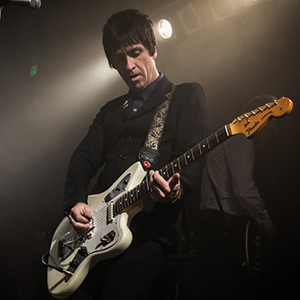
Johnny Marr

According to Noel Gallagher from the British band, Oasis, Johnny Marr is a guitar wizard. I would have to agree. He first became popularly known as the guitarist of The Smiths, where he teamed up with Morrisey to write such hits as the humorously titled "Some Girls are Bigger than Others," "This Charming Man," "How Soon is Now," and the featured song sample "The Headmaster Ritual." Despite the immense success of the band's 1986 album, The Queen is Dead, which is often ranked very highly in popular rock periodicals such as NME and Spin, Johnny Marr decided that it was time to quit The Smiths in June of 1987. However, Marr was only 23 at the time and was far from hanging up his guitar for other ventures.
Other acts Marr is associated with are The Pretenders, The The, Modest Mouse (a band he was an official member of from 2006 - 2009), and even another one of my favorites, John Frusciante. Marr played guitar on the Frusciante tracks "Enough of Me" and "Central" both on Frusciante's stereophonic masterpiece The Empyerean. Marr has also released several solo albums, his most recent effort, 2018's Call the Comet which features some of his best work including the jangly, ethereal "Hi Hello."
What I really like about Marr is that he has great guitar intuition. Much like say, Thurston Moore of Sonic Youth fame, he likes to experiment with different tunings and also unique chord voicings and picking patterns. In fact, it is his awesome right-hand picking patterns and lush chord choices which really make him stand out and inspire me.
Song Example
The Smiths - The Headmaster Ritual
official website
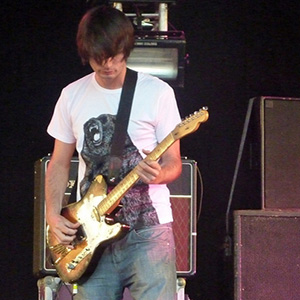
Jonny Greenwood

The first time I noticed Jonny Greenwood was about the time the entire world did, with his aggressive into the chorus of radiohead's 1993 hit, "Creep," which the British band reluctantly acknowledges made them internationally renowned. In fact, the song was such a huge hit that when I was at a party once in 1997 and was telling a partygoer that I was super excited by radiohead's new album, OK Computer, her only response was that radiohead was a one-hit-wonder...Kind of crazy since the band's second album, 1995's The Bends features some pretty amazing songs and guitar playing on songs like "Just" and "Street Spirit."
What stands out to me the most in Greenwood's playing is his ability to delicately fingerpick a beautiful part and then transition with ease into a raw and aggressive guitar phrase or solo. Greenwood is not a flashy soloist, but more of a painter of sonic landscapes with rich guitar timbres that often induce surreal daydreams. Perhaps one exception to his usual style is the song "Electioneering" that I chose to showcase as a song example because it shows Greenwood's versatility.
Song Example
radiohead - Electioneering
official website
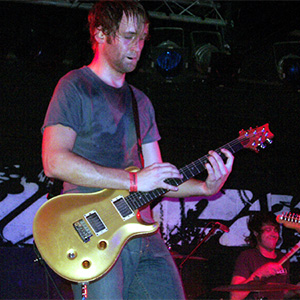
Dave Knudson

Dave Knudson might be described as a Math Rock or—maybe more appropriately—Indie Prog Rock enigma. His first major band was in the Mathcore group Botch, which gained legendary status as being at once cerebral and viscerally intense. He then went on to help form Minus the Bear (MTB) in 2001, when he traded his mainly distorted guitar sound for clean two-handed finger tapping combined with a unique guitar polyphony created with the band's other guitarist, Jake Snider.
Although Knudson is a great two-handed tapper, it was very noticeable with the 2007 release of MTB's Planet of Ice that Knudson was tapping less and concentrating more on his string bending technique and even adding some more shreddy type guitar stuff as heard on the song, "Dr. L'Ling." Starting around the band's 2005 release Menos El Oso, Knudson began to use Line 6 DL-4 modelers to create guitar samples that he can play back instantly by pressing one of the pedal's buttons. The sample can also be reversed, slowed down, or sped up and Knudson employed all these techniques in both the studio and during live performances.
As with all of the guitar players on this site, Knudson creates a very unique and special vibe with his guitar playing that I have yet to hear even remotely emulated. He is perfectly capable of being a Math Rock guitar virtuoso, but Minus the Bear allowed him to explore his other sonic interests in both his diverse guitar playing and also his unique use of original guitar pedal samples.
Song Example
Minus the Bear - Absinthe Party at the Fly Warehouse
bandcamp

Yvette Young

Yvette Young started out as a classically trained and competitive pianist and violinist. However, according to a recent interview with Andertons Music Co, Young didn't like the idea of music being a competition. The stress of that internal conflict is partially what lead to her developing an eating disorder that spurred a heart issue—both have since been resolved. While in the hospital for her medical issues, Young taught herself how to play guitar. Her favorite artists include radiohead, Cat Stevens, Sufjan Stevens, Hammock and Caspian, Mew, and Porches. Young's technique is predominately two-handed tapping, and her guitar playing approach was greatly influenced by her piano background in that she views the low strings as her left and on the piano and the high strings as her right hand on the piano. Her style has been described as Math Rock, Art Rock, and Progressive (Indie) Rock. Besides her solo work, Yvette plays guitar (and occasionally piano and violin—and sings!) in her three-piece band, Covet.
Young reminds me a bit of Knudson in that they both have a knack for very creative tapping and conjuring alluring melodies. However, I have very seldom seen Young play a conventional guitar chord and she often, almost always, plays in alternate tunings like FACBGE and FACGCE. She also sometimes plays a seven-string guitar as seen in her picture. I am amazed by both her technical prowess and precision (which she credits somewhat to her parents making her practice performing for hours a day) and also, just as importantly, her keen ear and ability to create complex yet enchanting and accessible melodies.
Song Example
Covet - Ares
bandcamp
About
coming soon
Demos
coming soon